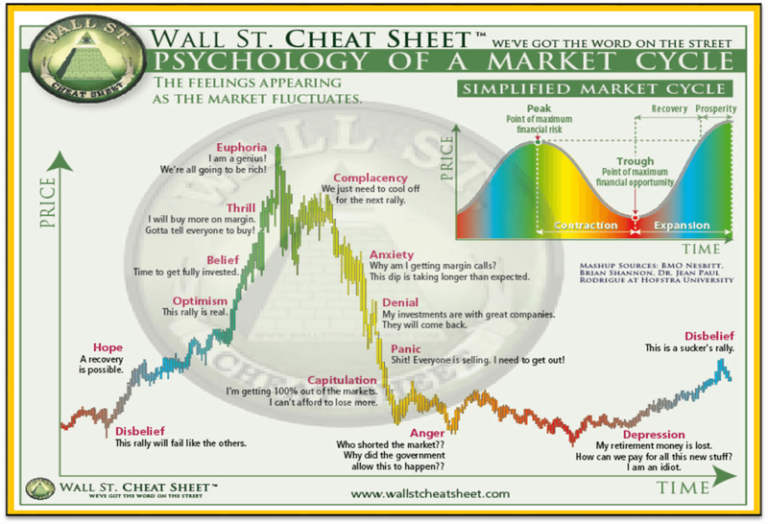
Today I’m going to illustrate why you shouldn’t always listen to the mainstream media or prominent figures about Crypto. Most often, these sources have their own motives to talk about an asset, which doesn’t always align with the truth. This applies to any asset class and most definitely Crypto!
I also want to stress how important it is to develop your own opinion – being open to listening, but taking everything you read or hear with a grain of salt.
Whether it’s intentionally misleading, or simply affected by bias, it’s always important to have a think about WHY an individual or an organisation holds a strong opinion on a certain asset.
Rather than being truthful statements, these strong opinions can simply boil down to generating clicks and views or trying to promote (or denounce) an asset.
News viewership and market manipulation have existed as long as the markets themselves, so it’s essential we know how to see through the headlines.
One of the most famous cases of a notable figure bashing Crypto – and then going against his own words – was Jamie Dimon, the CEO of JPMorgan.
Whether this was intentional market manipulation or not, Dimon publicly proclaimed Bitcoin was a “fraud”, in September 2017. He even went as far as claiming that he’d fire any employee from the company who traded the digital currency, for being “stupid.”
Not long after the strong statement, however, it was revealed that two firms associated with JPMorgan – JP Morgan Securities Ltd and Morgan Stanley – bought millions of Euros worth of a Bitcoin-backed fund on the dip that followed Dimon’s statement.
Even worse, it also turned out that Dimon was having secret meetings with the CEO of Crypto exchange Coinbase as early as 2018. JPMorgan even launched their own Cryptocurrency Stablecoin this year, took on Cryptocurrency exchange clients, and has most recently stated that Bitcoin prices could triple.
Another infamous example of terrible mainstream advice was American news network CNBC teaching investors how to buy Ripple’s XRP cryptocurrency.
The catch? Their tutorial aired on live TV when the coin was at $2.57. XRP only spent a matter of days at prices higher than this, before dropping and never again reaching that level in almost three years since.
Again, whether or not this was intentional market manipulation is up for debate. It’s highly likely the tutorial was just in the highest demand when the coin was surging in price.
On the other hand, it’s a sure-fire sign you should never blindly follow the advice of TV or prominent figures.
As you can tell from the above two examples, it’s highly important to form your own opinions in the investing world.
Three things are always certain:
Choose your sources of information carefully and understand the incentives and biases for each of their views. Be open to hearing arguments for all sides, but never take anything at face value.
The wisdom of crowds is a powerful tool when it’s not investing.
In fact, in the investing and trading world, you should almost be doing the exact opposite of the crowd. The CNBC “how to buy Ripple” segment is a perfect example of this – when everyone wants to buy XRP, it’s probably going to be a good time to sell.
Another iconic example of this is the shoe-shine indicator from Joe Kennedy back in 1929. Kennedy had a rule that it was time to exit the stock market whenever he got investment tips from a shoe-shine boy.
Today, the equivalent has been identified as the Uber driver or similar service person. When every man and his dog thinks a certain investment is a good idea, it’s time to get out of that investment!
A great illustration of this is the “Wall St Cheat Sheet” below:

The chart highlights the emotions felt at each stage of an asset’s market cycle, showing that we often “feel” the exact opposite way that we should act.
In summary, whether it’s mainstream media, a famous investor or celebrity, or simple emotions of fear and greed – it’s important to take these with a grain of salt and stick to your investment plan.
In many cases, it can even pay to go directly against the wider sentiment that’s portrayed in the news and from the general public.
If you stay grounded, think rationally, and keep your emotions in check – you’ll do better than most.

Bitcoin (and other crypto-currencies) are growing faster than any other asset in history and until relatively recently to participate you…

Many investors experiencing their first bull market become frozen when it’s time to take profits. They watch the numbers on…

Would you think I was crazy if I said we could: Borrow money without a bank or broker Take out…
Register for the FREE 90 minute
Crypto Training